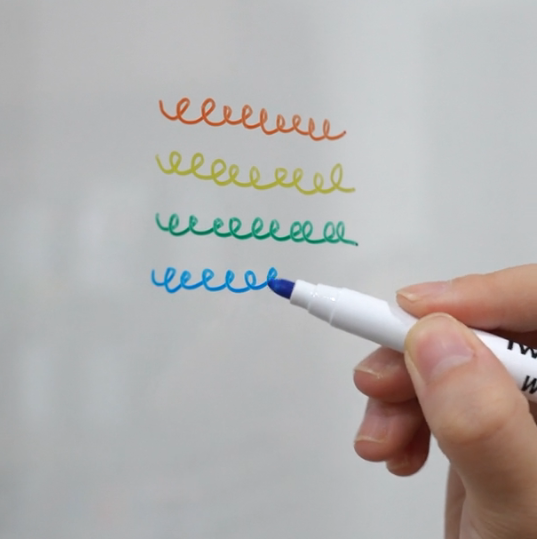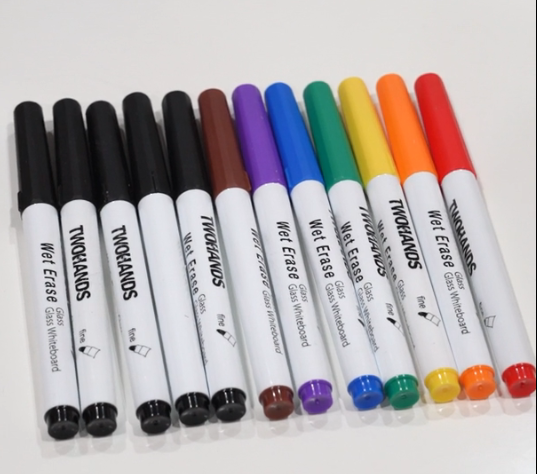Glass Whiteboard Markers are becoming indispensable for modern collaboration. Approximately 60% of modern workplaces utilize glassboards for brainstorming, indicating their growing demand. This underscores the importance of glass whiteboard markers as a key component for future workplace efficiency. The global glass whiteboard market projects steady growth, shaping communication in hybrid work environments by 2025. Businesses will evaluate options like the Top 5 Glass Whiteboard Markers for Your 2025 Needs, including the Top 5 Glass Whiteboard Markers, to optimize their collaborative tools.
At TWOHANDS, we understand the evolving needs of modern workspaces. Our commitment to innovation is rooted in our belief that every hand has a story to tell, and every stroke on a whiteboard can spark a new idea. Just as our founders, driven by a passion for creating exceptional products, embarked on a journey to redefine everyday essentials, we strive to provide the best tools for your collaborative endeavors. Our Glass Whiteboard Markers are designed with precision and care, ensuring a smooth, vibrant, and erasable experience that empowers your team to brainstorm freely and effectively. We believe in the power of connection and the magic that happens when ideas flow seamlessly, much like the effortless glide of our markers across a glass surface. Choose TWOHANDS for your Glass Whiteboard Markers and experience the difference that quality and thoughtful design can make in your collaborative environment.
Key Takeaways
- Glass whiteboards offer clear writing and erase easily. They last a long time and make offices look modern.
- New glass whiteboard markers are good for the environment. They work well with computer tools and help teams in hybrid workplaces.
- Markers now have quick-drying ink and many colors. They are comfortable to hold and you can refill them.
The Enduring Advantages of Glass Whiteboard Markers

Superior Clarity and Eraseability with Glass Whiteboard Markers
Glass whiteboards offer unmatched clarity for presentations and brainstorming sessions. Their non-porous surface prevents ink absorption, ensuring every mark appears crisp and vibrant. This smooth surface also allows for effortless erasing. Users can wipe away even dried ink without leaving smudges or ghosting, maintaining a pristine writing area for every new idea. This superior eraseability makes collaboration more efficient and visually appealing.
Durability and Longevity of Glass Whiteboard Surfaces
Glass whiteboard surfaces boast exceptional durability, a significant advantage over traditional options. They resist common issues like staining, ghosting, peeling, and cracking. Manufacturers design these boards to last for decades, often outliving the walls they mount on. Their robust construction makes them practically indestructible. Tempered glass, 5 to 10 times stronger than regular glass, provides enhanced strength. This inherent durability means glass whiteboards maintain their functionality and appearance for an extended period, offering a long-term investment for any workplace.
Aesthetic Appeal and Modern Design Integration
Glass whiteboards elevate the aesthetic of any modern workspace. Their sleek, frameless design and transparent or colored glass options integrate seamlessly into contemporary office environments. They project a professional and innovative image, enhancing the overall look and feel of boardrooms, meeting spaces, and collaborative zones. This modern design contributes to a more inspiring and sophisticated atmosphere, reflecting a forward-thinking organizational culture.
Key Trends Driving the Adoption of Glass Whiteboard Markers by 2025
Sustainability and Eco-Friendly Glass Whiteboard Markers
Workplaces increasingly prioritize sustainability. This focus extends to office supplies, including Glass Whiteboard Markers. Companies seek products with reduced environmental impact. Manufacturers respond by developing markers with eco-friendly features. These features include refillable ink cartridges, recycled materials in marker bodies, and non-toxic, low-odor inks. This shift aligns with corporate social responsibility initiatives. It also appeals to a workforce that values environmental consciousness. The demand for sustainable office solutions will continue to grow, making eco-friendly markers a significant trend.
Seamless Integration with Digital Collaboration Tools
Modern collaboration often blends physical and digital spaces. Glass whiteboards, combined with advanced markers, facilitate this integration. They serve as a bridge between traditional brainstorming and digital platforms. Many digital collaboration platforms now offer features for seamless integration with physical whiteboards. These platforms include Microsoft Teams, Zoom, Cisco WebEx, and Google Meet. Microsoft 365 apps, such as Teams, OneNote, and Whiteboard, also integrate with devices like Surface Hub 3. This connectivity allows teams to capture ideas from a physical whiteboard and instantly share them digitally. This ensures all participants, regardless of location, can access and contribute to the discussion. This integration enhances productivity and ensures no idea gets lost.
Meeting the Demands of Hybrid Work Models
Hybrid work models have become a standard for many organizations. Approximately 64% of employees report their company currently operates on a hybrid work model. This shift presents unique challenges for communication and collaboration. Employees often report that 75% believe their company’s technology needs improvement. Furthermore, 72% state their company needs to invest in new technologies to support remote work. Glass whiteboards and their markers address these needs effectively.
Digital whiteboards, often paired with physical glass boards, become shared spaces. Team members contribute ideas in real-time, regardless of their physical location. This collective approach pools diverse perspectives, leading to innovative solutions. Effective tools democratize the collaboration experience. They ensure everyone contributes freely to the discussion. These tools are simple to use, leveraging the familiarity of whiteboarding to encourage user adoption. They extend the meeting room ecosystem, working seamlessly with video conferencing devices and applications. Easy and fast installation allows wide deployment throughout an organization’s meeting rooms.
Glass whiteboards support equitable participation. Remote participants gain the same visibility and ability to contribute as those in the room. This makes virtual participation less isolating and more engaging. They also provide persistent workspaces. These shared digital spaces remain accessible to all team members, regardless of location or time zone. This is crucial for sustained asynchronous collaboration. Teams can easily switch between in-person whiteboarding, video conferencing, and content sharing. This maintains the flow of the meeting without interruption. Visual project boards provide clear status updates without requiring synchronous meetings. Persistent chat threads maintain context across conversations. Collaborative whiteboards enable real-time co-creation across distributed teams.
Innovations in Glass Whiteboard Marker Technology
Smudge-Resistant and Quick-Drying Inks for Glass Whiteboard Markers
Marker technology continues to advance, focusing on user experience. Manufacturers now develop inks that dry almost instantly on glass surfaces. This innovation significantly reduces smudging, a common frustration during collaborative sessions. Quick-drying formulas ensure clean hands and pristine whiteboards, even with rapid writing or erasing. These advanced inks also offer enhanced opacity, making written content more visible from a distance. This improves overall readability and presentation quality.
Expanded Color Palettes and Specialty Inks
The range of available marker colors has expanded far beyond basic options. Workplaces now access vibrant hues and pastels, allowing for more dynamic visual organization and creative expression. Beyond standard colors, specialty inks are emerging. For instance, some specialized glass whiteboards now utilize fluorescent marker ink. This ink becomes visible only under specific lighting conditions. Its luminescent properties activate when users write upon the surface. A recording device behind the glass captures the writing, and software automatically reverses the image for correct viewing. This technology allows seamless content sharing without blocking sightlines, offering a futuristic approach to presentations.
Ergonomic and Refillable Marker Designs
Marker design also sees significant innovation, prioritizing user comfort and sustainability. Ergonomic designs feature comfortable grips and balanced weights, reducing hand fatigue during extended use. This allows users to write for longer periods without discomfort. Furthermore, refillable marker systems are gaining popularity. Refillable whiteboard markers offer significant cost savings because refills are considerably less expensive than purchasing new markers. They also provide environmental benefits by reducing plastic waste, aligning with sustainability initiatives.
- Refillable markers are cost-effective, offering long-term savings compared to disposable options.
- They have a longer lifespan, reducing the frequency of replacements.
- They are a more sustainable choice, contributing to reduced plastic waste and often being made from recycled materials.
These design advancements make Glass Whiteboard Markers more practical and environmentally responsible.
Practical Applications of Glass Whiteboard Markers Across Workplaces

Enhancing Corporate Boardrooms and Meeting Spaces
Glass whiteboards significantly boost productivity and engagement in corporate boardrooms. They are crucial for brainstorming sessions. Engineers, designers, and architects use these boards for design work, fostering strong team participation. Programmers display concepts for new applications, allowing for rapid idea refinement and detail addition. Participants easily snap photos of work sessions to record information. They then erase the board for new sessions. Strategically placed glassboards display concepts and information throughout the day. This stimulates creativity and enhances productivity. These boards are also useful for scheduling, displaying timetables, meeting schedules, and inter-office communication. This includes memos, messages, and announcements. Glass whiteboards encourage team members to share ideas and collaborate more effectively. They empower contributions, leading to innovative solutions and improved productivity. They elevate meeting rooms by allowing seamless transitions between topics. This minimizes preparation time and maximizes productivity. Glass whiteboards offer a sleek, professional, and low-maintenance choice. They blend design with utility. Their scratch- and stain-resistant surfaces and easy erasing without ghosting contribute to a professional atmosphere. Some models include magnetic backing. This allows for combining analog sketching with document display, ideal for project planning and team standups.
Fueling Creativity in Studios and Design Firms
Changeable glassboards foster creativity in design firms. They transform corporate offices into creative havens. These boards provide customizable writable surfaces. Teams update them with different graphics or branding to align with current projects. This flexibility allows teams to quickly modify graphics as projects evolve or company branding changes. This ensures the workspace remains relevant. This ease of customization encourages team members to share ideas and collaborate more effectively. It empowers them to contribute thoughts, leading to innovative solutions and improved productivity. The dynamic nature of these glassboards maintains creative energy and cultivates a culture of innovation. Design firms use interactive whiteboards for large-scale design mockups. Interior designers sketch floor plans, furniture layouts, and color schemes on a grand scale. This provides an immersive experience for clients and allows for experimentation with digital tools. These whiteboards foster creative environments for team brainstorming sessions. They transform offices into collaborative design hubs. Teams create vibrant mood boards and easily modify content, supporting an iterative design process. Interactive whiteboards turn ordinary office spaces into dynamic collaborative environments. They promote a culture that inspires fresh perspectives and innovative approaches. They facilitate seamless communication for sharing sketches and presenting finalized designs. Digital whiteboards integrate with 3D modeling software. This allows designers to visualize projects in three-dimensional space. This helps present realistic renderings to clients, providing a clear understanding of the final product. Design firms also use digital whiteboards with augmented reality applications. They superimpose virtual furniture and decor onto real-world spaces. This allows clients to visualize products in their own homes or offices, enhancing engagement and streamlining decision-making.
Supporting Education and Training Centers
Glass whiteboards offer significant pedagogical benefits in educational and training environments. Colored glass boards provide an enhanced visual experience for students with dyslexia. These students may find typical whiteboards visually challenging. This leads to better engagement, higher self-esteem, and a greater desire to learn. Whiteboard work encourages movement, increasing alertness and aiding memory encoding. It engages multiple senses, supporting various learning styles. It also helps students develop spatial and body awareness. Working on large vertical surfaces assists in developing physical dexterity and control. Occupational therapists often encourage this practice. Whiteboards facilitate shared knowledge. They allow users to write down and display information, freeing them from having to remember everything. They support teachers by creating flexible learning environments. This enables spontaneous sharing, learning, and assessment. Teachers quickly gauge student understanding by having them complete problems or explain their thinking. Non-digital whiteboards offer an alternative way to focus attention. They stimulate imagination and enhance the learning process, especially in an era of digital fatigue. The use of large whiteboards excites students, encourages teamwork, differentiates instruction, and fosters deep engagement. This leads to improved communication and critical thinking. Transparent whiteboards enhance online learning. Instructors maintain eye contact with students via video. This fosters a sense of social agency and makes lessons feel more personalized. Instructors’ eye gaze guides students’ attention to relevant information. This supports signaling, temporal contiguity, and segmenting principles. It helps students build connections among information more effectively.
Visual Communication in Healthcare Facilities
Healthcare facilities increasingly adopt glass whiteboards for clear visual communication. These boards serve as essential tools for patient care coordination. Medical teams use them to display patient information, treatment plans, and daily schedules. This ensures all staff members have immediate access to critical updates. Nurses and doctors quickly update patient statuses, medication schedules, and discharge plans. This reduces miscommunication and improves patient safety. In operating rooms, surgeons use glass whiteboards to outline procedures and mark anatomical details. This enhances precision and team alignment. Training centers within hospitals utilize these boards for medical education. They present complex anatomical diagrams and procedural steps. This creates an interactive learning environment for medical students and staff. Glass Whiteboard Markers provide clear, vibrant lines that are easily visible from a distance. This is crucial in fast-paced healthcare settings. The non-porous surface of glass whiteboards also supports hygiene protocols. They are easy to clean and disinfect, preventing the spread of pathogens. This makes them a practical and safe choice for clinical environments.
Integrating Glass Whiteboard Markers into the Modern Workplace
Compatibility with Smart Whiteboard Systems
Glass whiteboards seamlessly integrate with modern smart whiteboard systems. These systems often feature cameras or sensors. They capture content written on the glass surface. This allows for real-time sharing with remote team members. Digital overlays can enhance physical drawings. This creates a dynamic collaborative experience. This compatibility bridges the gap between analog and digital workflows. It ensures all participants contribute effectively, regardless of location.
Installation and Maintenance Best Practices
Proper installation and maintenance ensure the longevity of glass whiteboards. For long-term maintenance, users must employ correct cleaning agents and tools. Recommended cleaners include Windex® or any standard glass cleaner. Abrasive cleaners can dull the glass surface. Soft cloths, microfiber eraser cloths, or rare earth magnetic erasers are ideal for wiping. Regularly cleaning eraser cloths removes ink residue. Glass whiteboards are smooth, non-porous, and stain-resistant. They last for decades with proper care. Daily cleaning prevents stains from settling. Always ensure marks are fully dry before erasing. This prevents smearing. For polished glassboards, a circular cleaning motion avoids reflection streaks.
Cost-Benefit Analysis for Adopting Glass Whiteboard Markers
Implementing glass whiteboards involves higher initial investment costs. Tempered glass, magnetic features, and custom finishes contribute to this elevated price. Labor costs for installation also significantly increase the overall expense. Complex installations require additional labor and specialized tools. Despite the higher upfront cost, glass whiteboards offer substantial long-term benefits. Their durability and longevity reduce replacement needs. This provides a strong return on investment over time. They also enhance workplace aesthetics and collaboration efficiency.
The Market Landscape for Glass Whiteboard Markers
Leading Brands in Glass Whiteboard Manufacturing
The glass whiteboard market features several prominent manufacturers. These companies establish industry standards for quality and innovation. Leading brands include Quartet, Clarus, and Ghent. These manufacturers offer diverse product lines. They cater to various aesthetic and functional needs. For example, brands provide frosted glass, which features a semi-transparent etch. This option softens wall hues in modern offices. Neon Black offers a unique, high-contrast surface for neon markers. White glass provides a clean, stain-free alternative to traditional whiteboards. Opaque glass offers a clear, modern look. Back-painted options allow for custom colors and branding. Magnetic glass whiteboards come in various colors and sizes. They can include silk-screened grids for organizational purposes. Signage options are also customizable for welcome boards.
Emerging Innovators in Marker Technology, including TWOHANDS
Innovation in marker technology continues to evolve. New companies focus on enhancing user experience and sustainability. TWOHANDS stands out as an emerging innovator in this space. The company develops markers with advanced ink formulations. These inks offer superior clarity and quick-drying properties. TWOHANDS also prioritizes ergonomic designs. Their refillable markers reduce waste and offer long-term value. These advancements meet the growing demand for high-performance, eco-friendly office supplies.

Future Growth Projections and Market Opportunities
The glass whiteboard market anticipates significant growth. Several new market segments are adopting these tools.
| Market Segment | Description |
|---|---|
| Education Sector | Schools and universities use durable, easy-to-clean glass whiteboards. |
| Corporate Offices | Businesses favor glass boards for aesthetics and functionality in meeting rooms. |
| Healthcare Facilities | Hospitals use hygienic glass boards for patient information and staff communication. |
| Hospitality Industry | Hotels and restaurants use sleek glass boards for daily specials and event schedules. |
| Residential Use | Consumers use glass boards in home offices and kitchens for organization. |
The market faces challenges, such as the high cost of advanced interactive whiteboards. Competition from digital collaboration tools also exists. However, opportunities arise from digital transformation in education and corporate sectors. Government initiatives and the integration of AI and cloud technologies also drive growth. The increasing installation of glass whiteboards in conference rooms highlights a key trend. Their ease of cleaning makes them a preferred choice for creative brainstorming.
Glass Whiteboard Markers are indispensable for future workplaces, driving dynamic collaboration and innovation. The continuous evolution of collaborative tools will profoundly impact business operations. Businesses must strategically embrace these trends, integrating advanced solutions like TWOHANDS markers for sustained success and competitive advantage.
FAQ
What makes glass whiteboard markers a superior choice for modern workplaces?
Glass whiteboard markers provide superior clarity and eraseability. They prevent ghosting and smudging. This ensures a clean, professional appearance for all collaborative efforts.
How do glass whiteboard markers contribute to workplace sustainability?
Many glass whiteboard markers feature refillable designs and eco-friendly inks. This reduces plastic waste. It also aligns with corporate environmental responsibility initiatives.
Do glass whiteboard markers work with digital collaboration tools?
Yes, smart whiteboard systems capture content from glass boards. They share it seamlessly with digital platforms. This bridges physical and virtual collaboration spaces effectively.
Post time: Nov-17-2025


